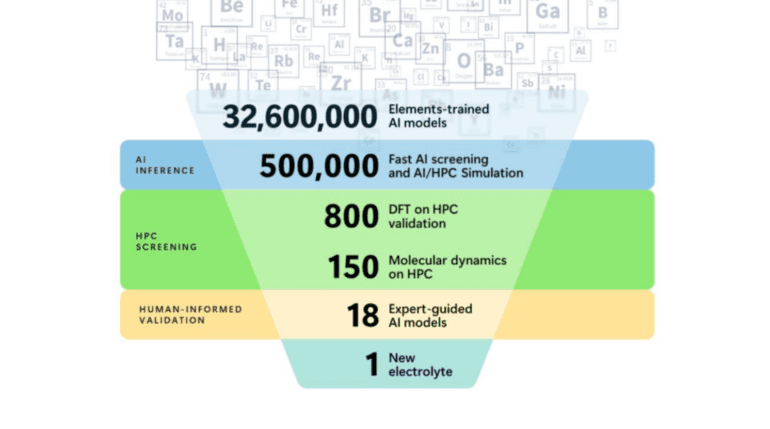TL;DR:
- Microsoft collaborates with the Pacific Northwest National Laboratory (PNNL) using Azure Quantum Elements.
- Azure Quantum Elements combines AI and HPC techniques for scientific computing.
- No quantum computer was used; the focus is on the future integration of technologies.
- Researchers used AQE to narrow down 32 million materials to 18 promising candidates for a battery project.
- The AI accelerator in AQE played a crucial role in reducing the candidate pool.
- This streamlined process resulted in a battery prototype in just 18 months.
- The collaboration aims to make AI accessible to scientists for the discovery of innovative materials.
- Quantum computing’s practical application is still a few years away.
Main AI News:
In a groundbreaking collaboration, Microsoft has partnered with the U.S. Department of Energy’s Pacific Northwest National Laboratory (PNNL) to leverage its Azure Quantum Elements service, achieving remarkable results in the realm of materials discovery. The project has successfully narrowed down millions of potential new battery materials to a select few, with one of them progressing to the prototype stage.
Before delving into the “quantum” aspect of “Azure Quantum Elements,” it’s important to clarify that no quantum computer was employed in this endeavor. Azure Quantum Elements, introduced last summer, melds the power of artificial intelligence (AI) with traditional high-performance computing (HPC) techniques. It essentially serves as a scientific computing workbench, offering the potential for future access to Microsoft’s quantum supercomputer. While this particular project did not involve qubits, the ultimate vision is to synergize these technologies over time.
Krysta Svore, the head of Microsoft Quantum, shared insights into the project’s goals. The primary objective was to test the limits of what Azure Quantum Elements (AQE), particularly its AI accelerator, could achieve in advancing the discovery of materials. Using AQE, PNNL researchers initially assessed a vast pool of 32 million inorganic materials, ultimately identifying 18 promising candidates for their battery project. The AI models within AQE were instrumental in narrowing down the pool to approximately 500,000 candidates. Subsequently, existing HPC techniques were employed to pinpoint the 18 most promising materials for further exploration. Typically, this process would entail several years of effort to develop a prototype battery. However, with AQE, the researchers achieved this milestone in just 18 months.
Tony Peurrung, PNNL’s Deputy Director for Science and Technology, emphasized the significance of this collaboration. He stated, “We believe the intersection of AI, cloud, and high-performance computing, along with human scientists, is key to accelerating the path to meaningful scientific results.” The partnership with Microsoft aims to democratize AI access for scientists, with the potential to uncover unconventional yet valuable materials and approaches. This marks the initial phase of an exciting journey to expedite scientific discoveries.
While quantum computing enthusiasts anticipate breakthroughs in solving chemistry and material science challenges, the reality is that practical quantum computers are still several years away. Presently, we are in the era of noisy intermediate-scale quantum (NISQ) computing. Nonetheless, Krysta Svore remains optimistic that Microsoft will fulfill its ambitious plan to construct a quantum supercomputer utilizing Majorana-based qubits within the next decade.
In the current context, this endeavor, though rooted in legitimate scientific exploration, can be viewed as a strategic public relations initiative. Quantum computing’s integration into practical processes remains a distant horizon, given the evolving state of the technology.
Conclusion:
Microsoft’s partnership with PNNL, leveraging Azure Quantum Elements, demonstrates a significant leap in materials discovery. The synergy of AI, cloud, and high-performance computing paves the way for expedited scientific advancements. However, practical quantum computing applications are still a few years away, suggesting continued evolution in the market’s technological landscape.

